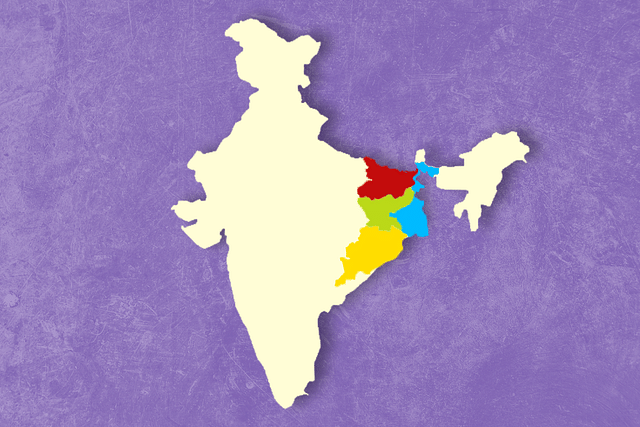Infrastructure
BJP's Pitch For Eastern States — The Purvodaya Master Plan In Party's 2024 Manifesto
- BJP vows major infrastructure push for eastern India, aiming to address the region's considerable infrastructure deficit.

The BJP's manifesto outlines a plan for extensive infrastructure development in the eastern region.
The Bharatiya Janata Party (BJP) manifesto, unveiled by Prime Minister Narendra Modi on 14 April, pledges to create a comprehensive infrastructure plan for eastern India.
Dubbed the "Purvodaya Master Plan", the idea forms part of the chapter "Balanced Regional Development", one of the 24 different guarantees mentioned in the 76-pages manifesto — titled Modi ki Guarantee 2024.
Coming less than a week before the seven phased general election kicks off from 19 April, the eastern pitch in the manifesto could represent a significant new proposal.
Before debating on the promise being made, let's take a moment to understand why it holds significance.
Eastern India, comprising states of West Bengal, Bihar, Odisha and Jharkhand, faces a considerable infrastructure deficit. This gap becomes even wider when we talk about regions.
For instance, the eastern Indian state of Bihar — the country’s third largest, with over 100 million people, has only three airports, while its southern counterpart, the mineral-rich state of Jharkhand, has just two. Meanwhile, Uttar Pradesh, a neighbouring state, boasts 15 operational airports, the highest in the country.
Similarly, the railway network in the eastern region grapples with some of the highest passenger volumes, resulting in lengthy waiting lists that frequently surpass capacity limits.
This imbalance between supply and demand, a persistent challenge for Indian Railways, is particularly pronounced for trains traveling eastward, making rail travel exceedingly challenging.
To put this in perspective, the infrastructure distancing of east India from its main markets and trade gateways has led to economic insulation and caused immense structural damage to the eastern economy.
This problem is exacerbated by the fact that eastern states, such as Jharkhand are the repository of 40 per cent of the nation's minerals — yet suffer from inadequate infrastructure.
Lacklustre Show
To be fair, the BJP-led National Democratic Alliance (NDA) government has indeed initiated infrastructure development plans in the eastern region during its 10-year tenure. However, there have been concerns about delivery.
So, while Ayodhya or Gwalior gets a swanky airport in two years, the Airports Authority of India (AAI) is yet to start work on a new terminal building at Darbhanga airport in Bihar, despite tender being awarded in February this year.
For the uninitiated, Darbhanga airport has emerged as the top airport in the country under the Regional Connectivity Scheme (RCS) — Ude Desh Ka Aam Nagrik (UDAN) since commercial flights began on 8 November 2020.
Similarly, progress on proposed expressways in the eastern region has been limited, with only a few projects, like the Varanasi-Kolkata expressway, seeing actual construction work.
Political Messaging
An essential question: what drove the inclusion of a focused development strategy for east India in the BJP's manifesto?
The answer may lie in the electoral landscape — collectively, the eastern states hold 117 Lok Sabha seats, wielding significant influence. Historically underserved in terms of development, voters in these regions are now posing challenging questions, demanding answers from the ruling party.
Moreover, the BJP faces a perceptual hurdle as major infrastructure initiatives seem concentrated in the Prime Minister's home state. While projects like the Ahmedabad-Mumbai bullet train are advancing, plans for routes like Delhi-Varanasi (813 km) and Varanasi-Howrah (760 km) await finalisation.
Meanwhile, the opposition is stepping up its efforts, promising to address the development deficit in the east. For example, the Rashtriya Janata Dal (RJD) manifesto pledges five new airports for Bihar.
As for the principal opposition parties in the east — Trinamool Congress, Biju Janata Dal (BJD) and Jharkhand Mukti Morcha (JMM) — while their manifestos for the upcoming Lok Sabha polls are yet to be released, it's expected they will seize upon the Centre's commitments.
Having been in power for a decade, the NDA government cannot shift the narrative easily; it must answer for the region's continued underdevelopment. It's ironic that this is the same government that managed to establish a new AIIMS in Deoghar in just three years and build a modern airport in the temple town in four years.
The Vote Factor
It's inspiring to witness the growing recognition of the issue of uneven development, with parties vying to address it. Yet, will these efforts translate into votes? After all the return on investments in the infrastructure is not immediate.
While some may believe in these promises, others remain sceptical. Manifesto commitments hold significance, but voters cannot be assumed to blindly support them.
If the gambit pays off, it could pave the way for the party’s strategy in subsequent elections in other states.
Support Swarajya's 50 Ground Reports Project & Sponsor A Story
Every general election Swarajya does a 50 ground reports project.
Aimed only at serious readers and those who appreciate the nuances of political undercurrents, the project provides a sense of India's electoral landscape. As you know, these reports are produced after considerable investment of travel, time and effort on the ground.
This time too we've kicked off the project in style and have covered over 30 constituencies already. If you're someone who appreciates such work and have enjoyed our coverage please consider sponsoring a ground report for just Rs 2999 to Rs 19,999 - it goes a long way in helping us produce more quality reportage.
You can also back this project by becoming a subscriber for as little as Rs 999 - so do click on this links and choose a plan that suits you and back us.
Click below to contribute.
Latest